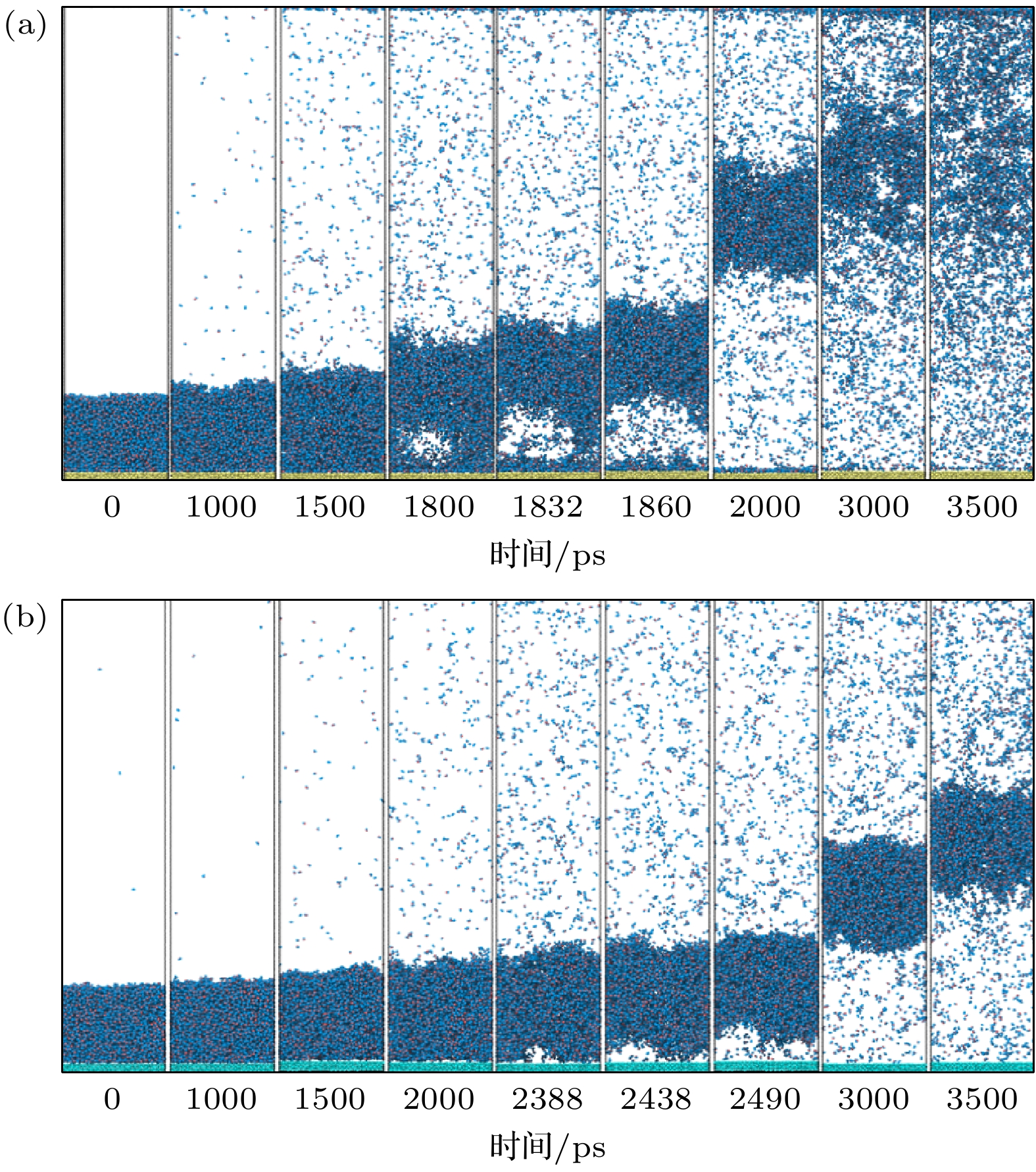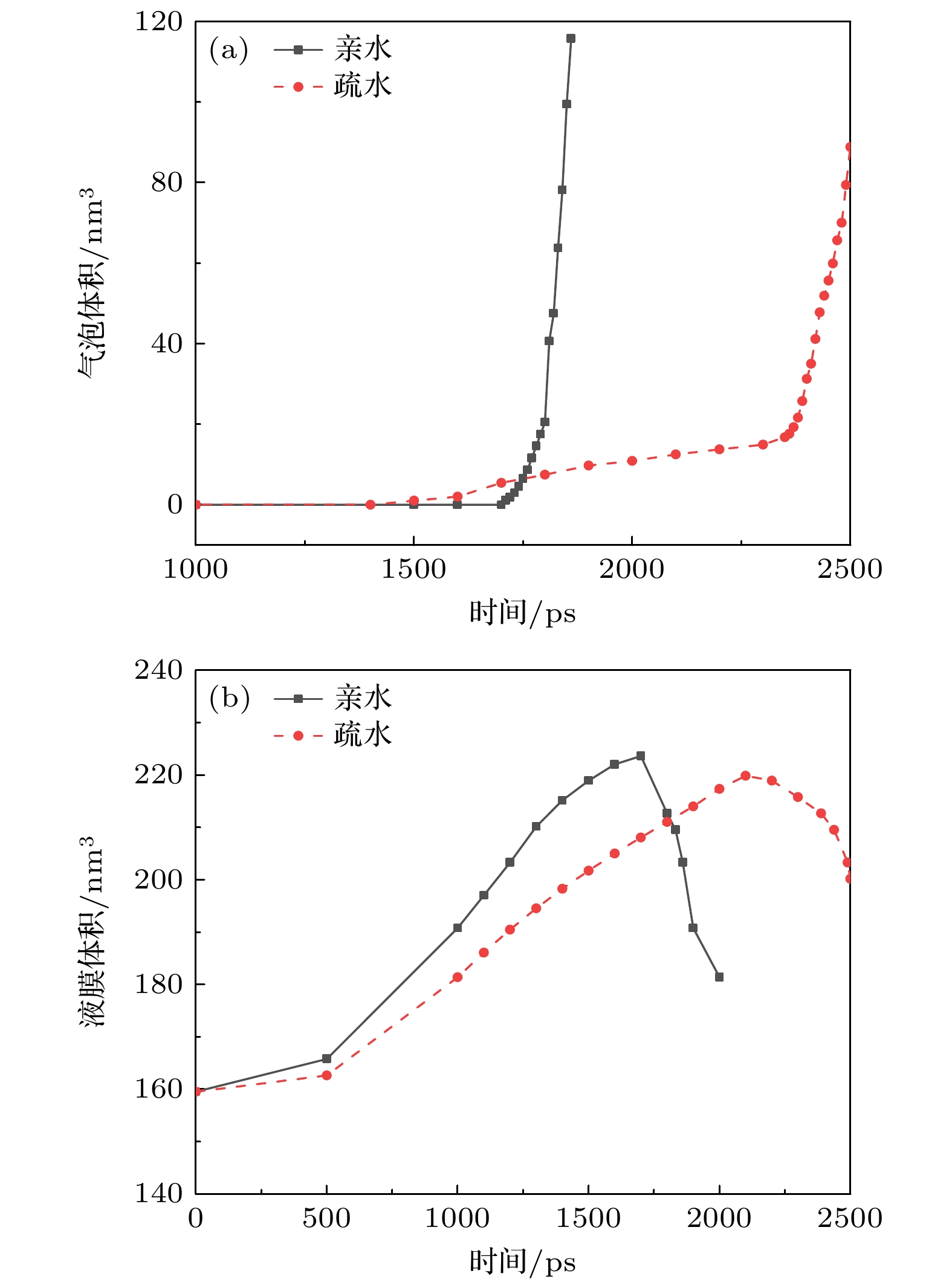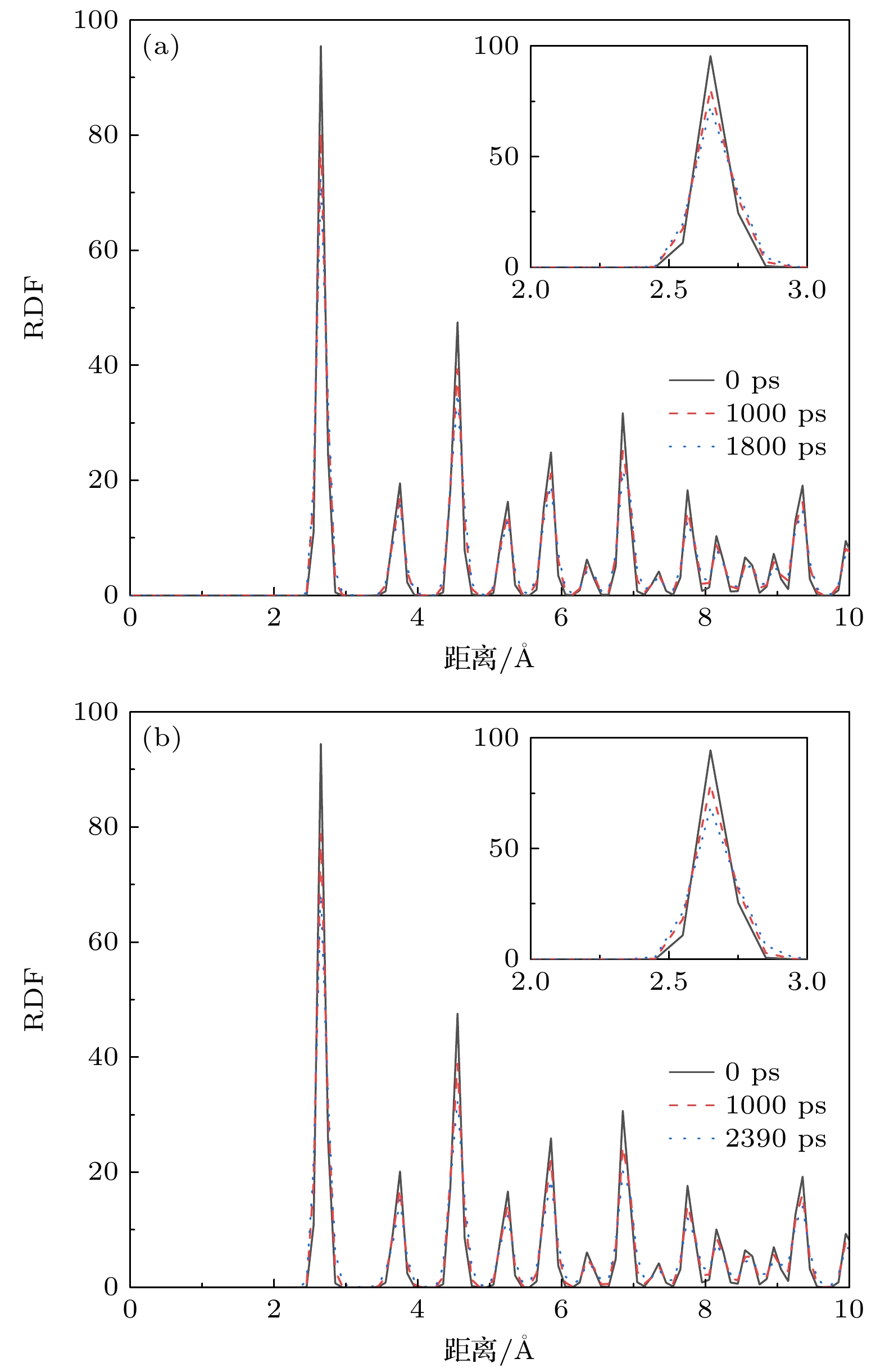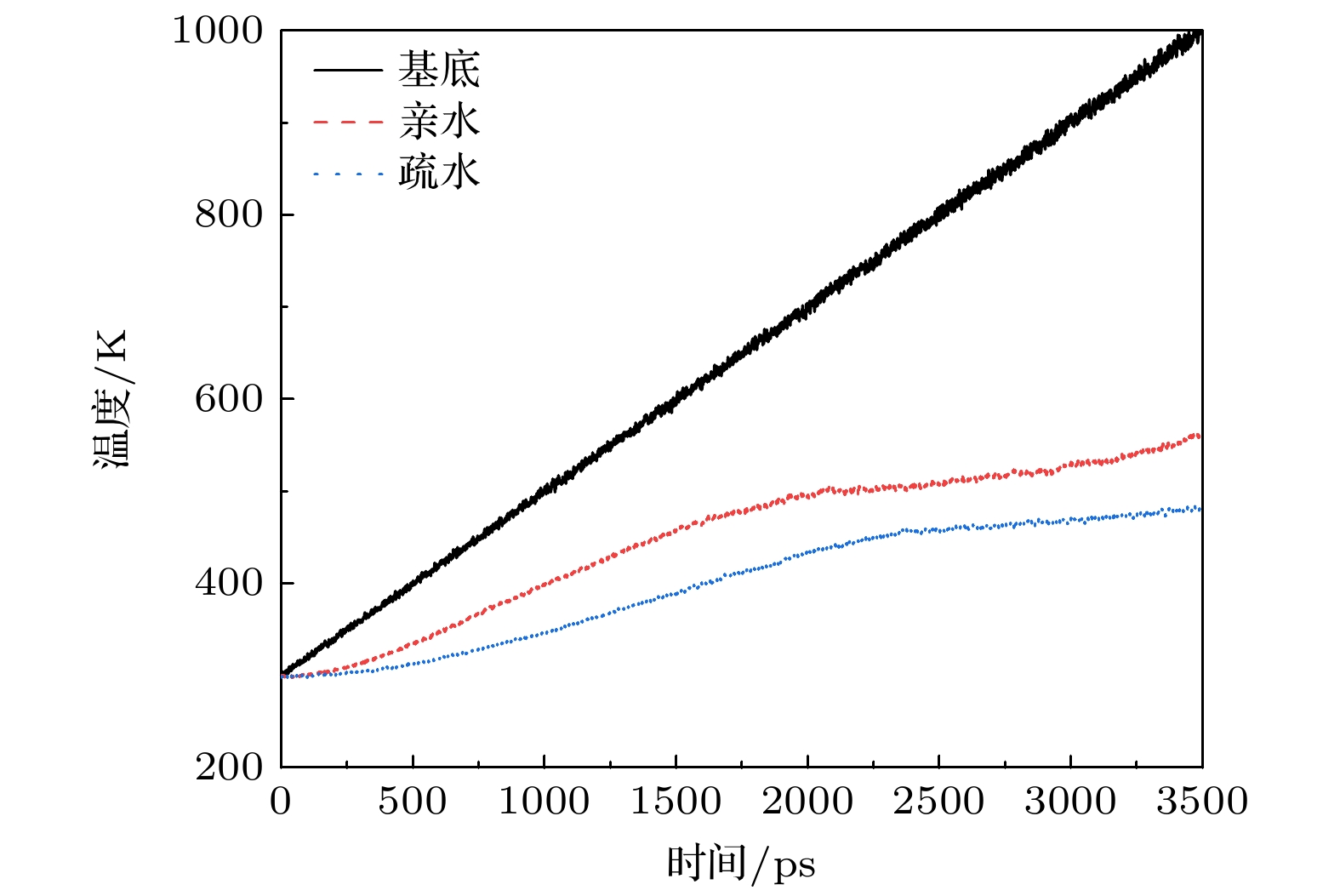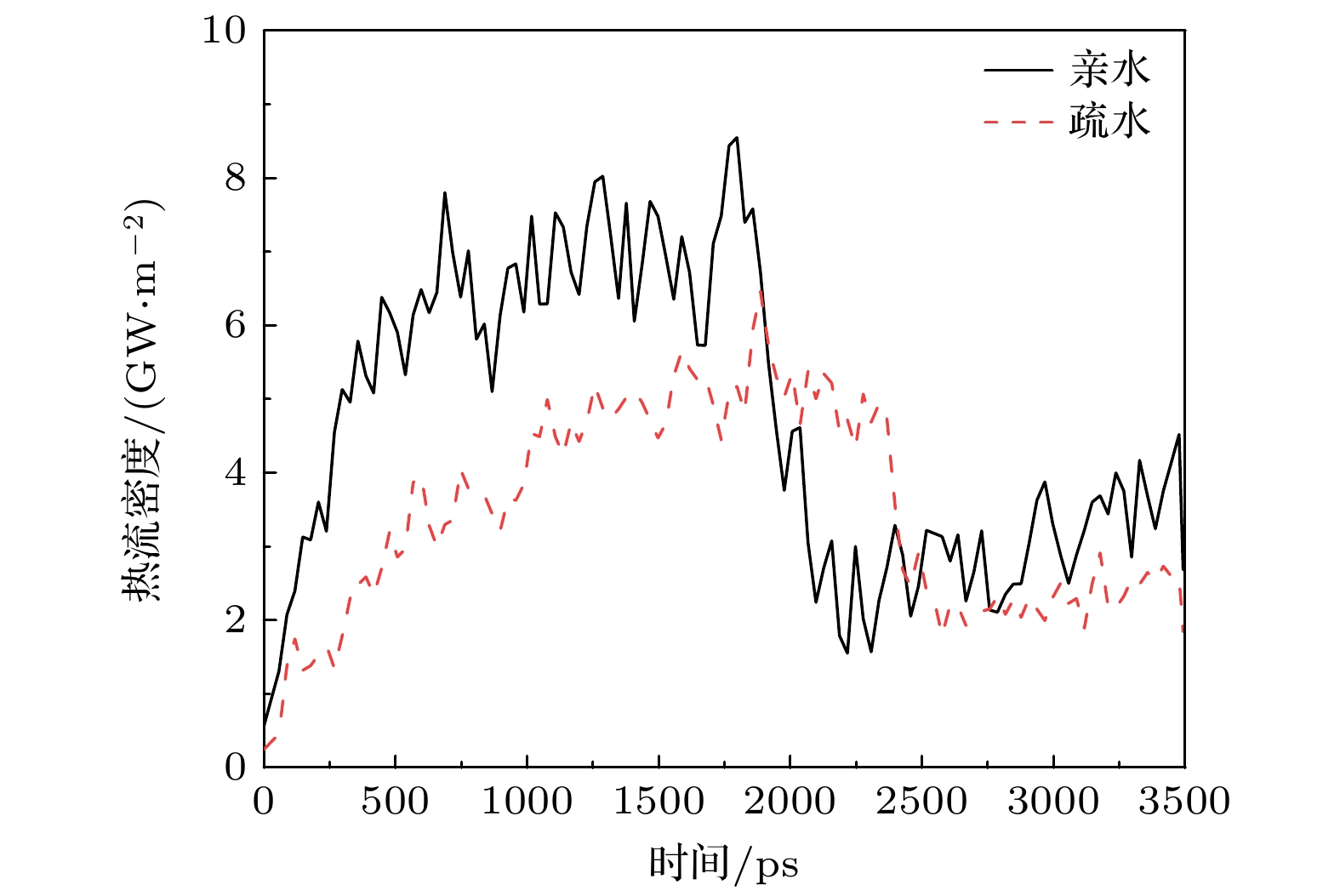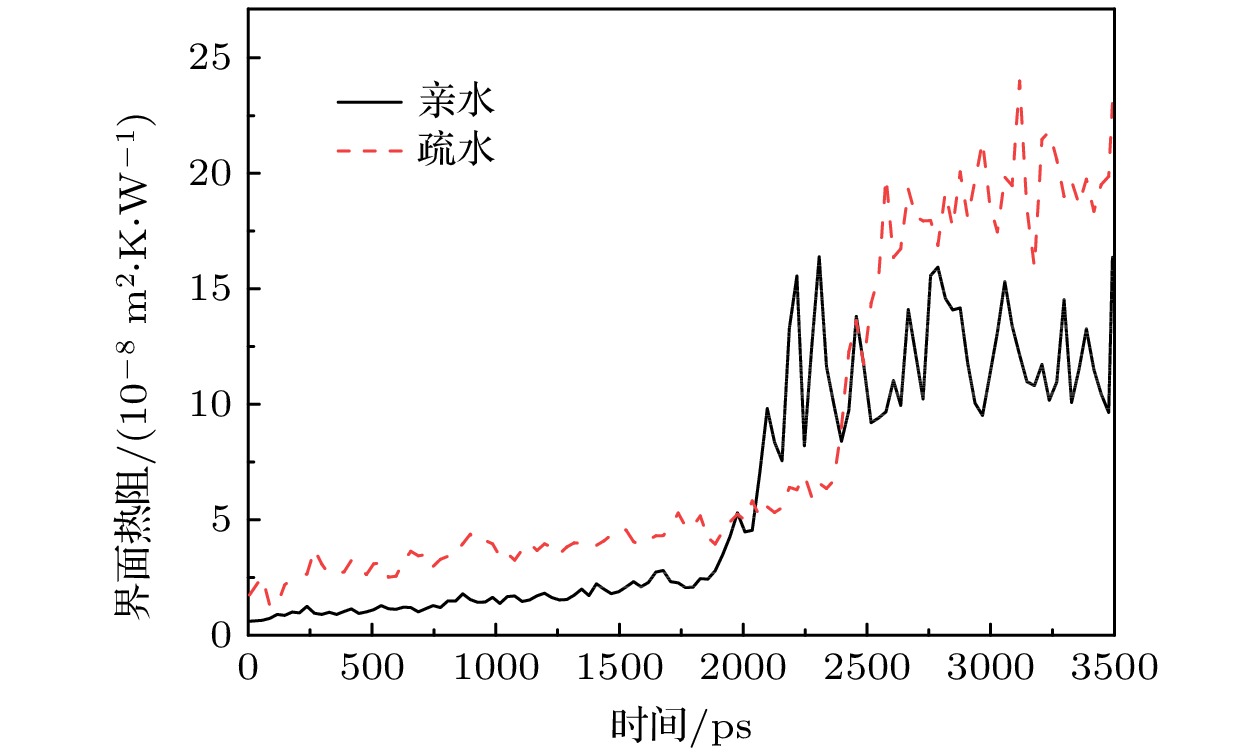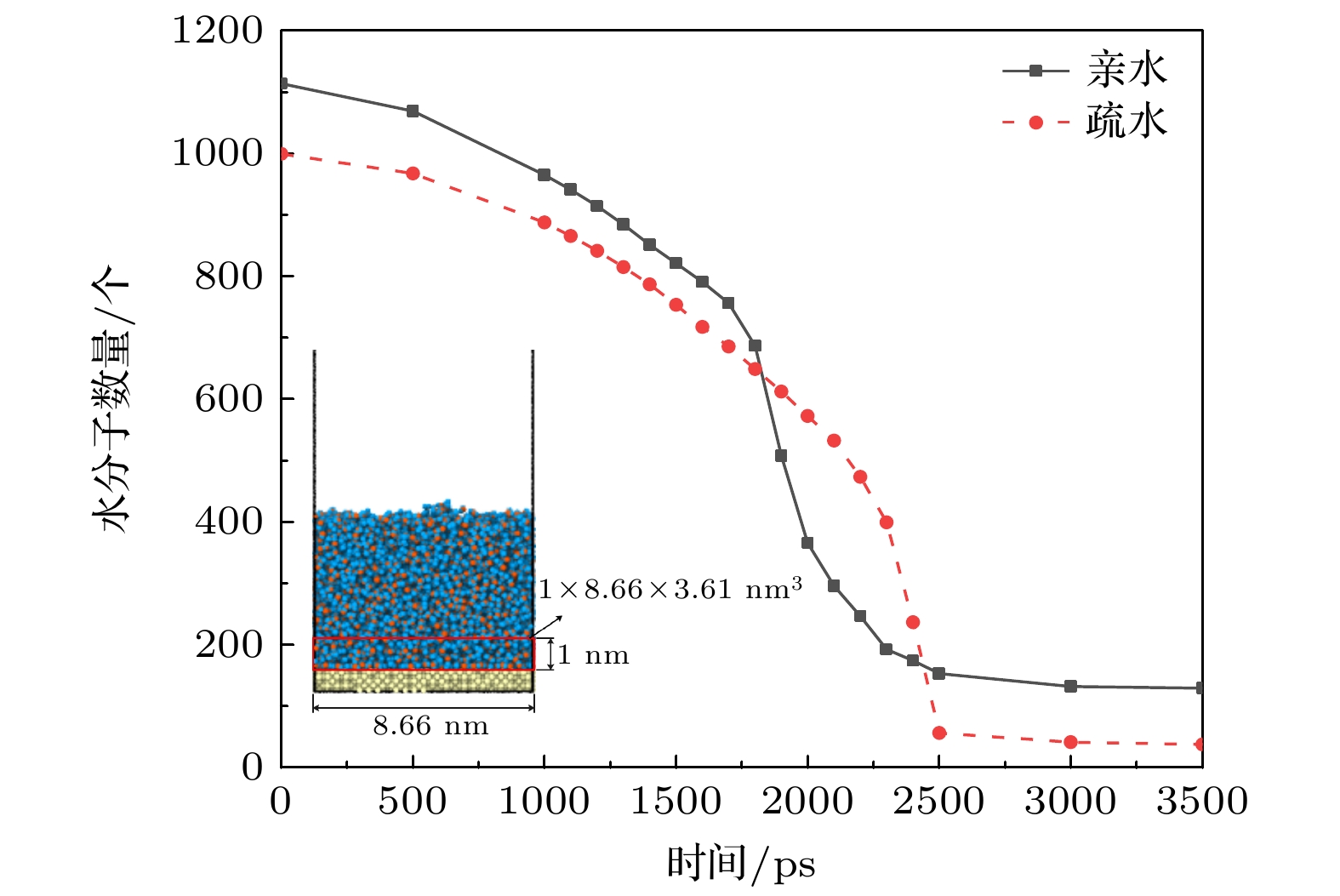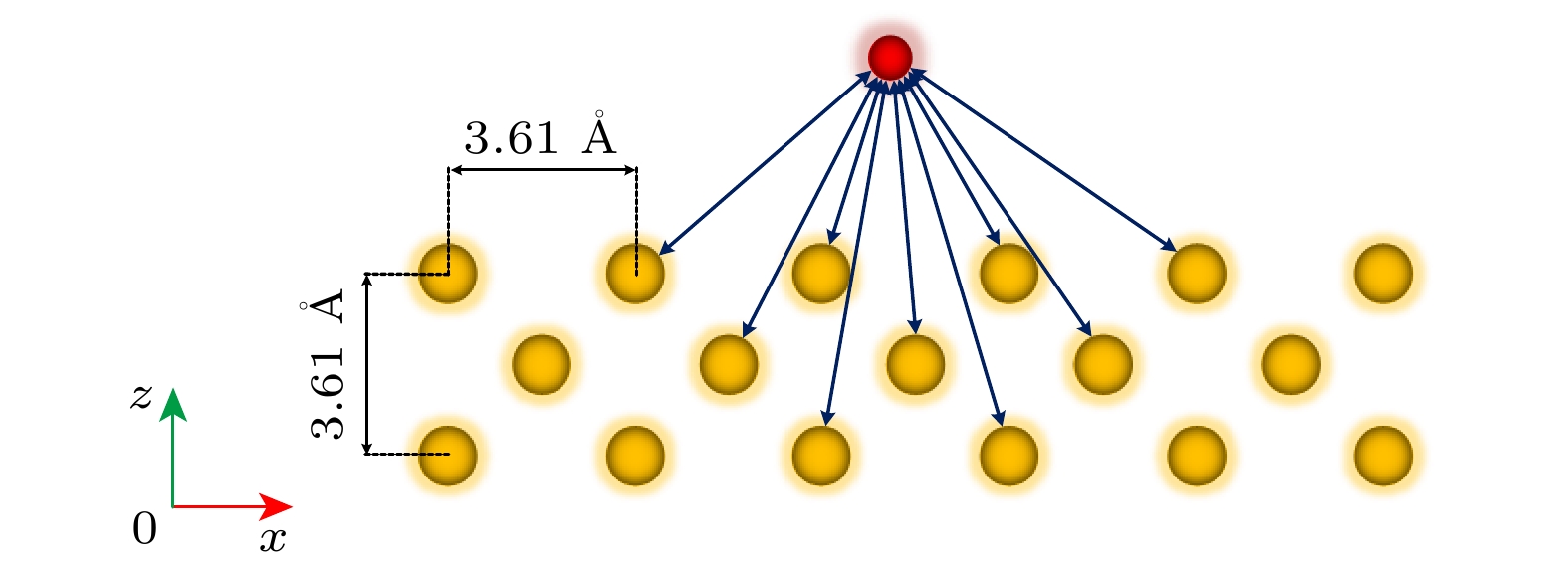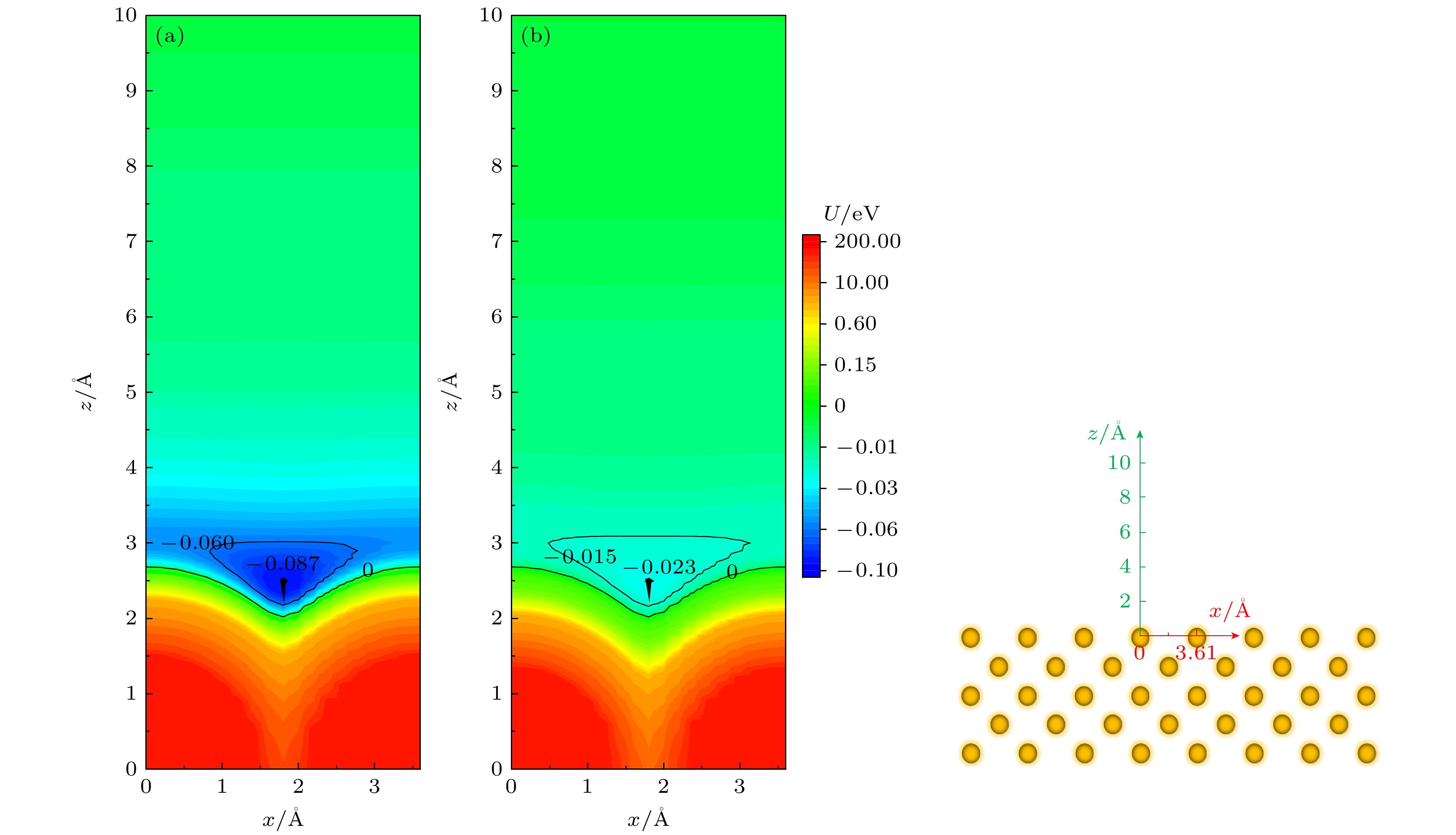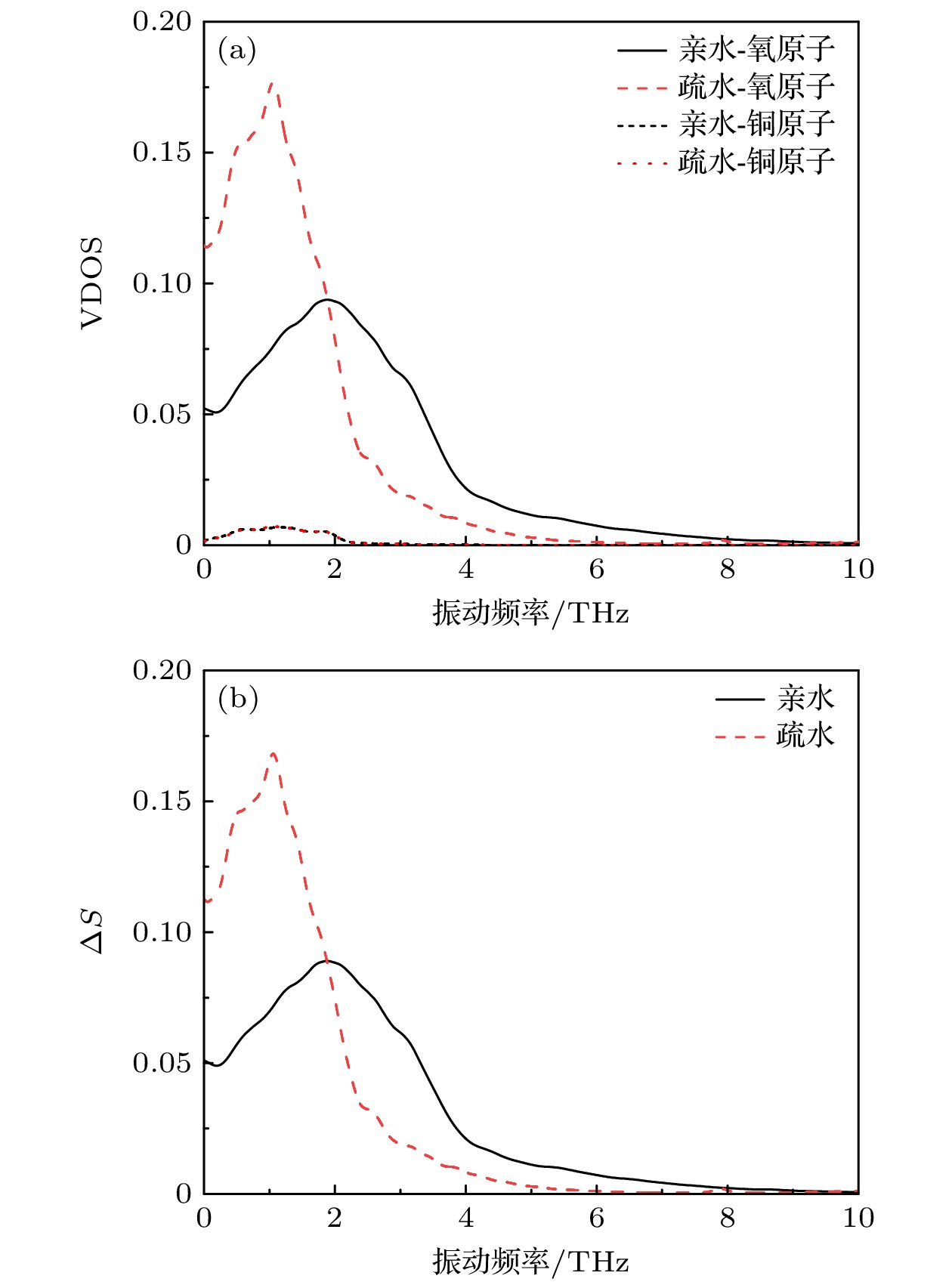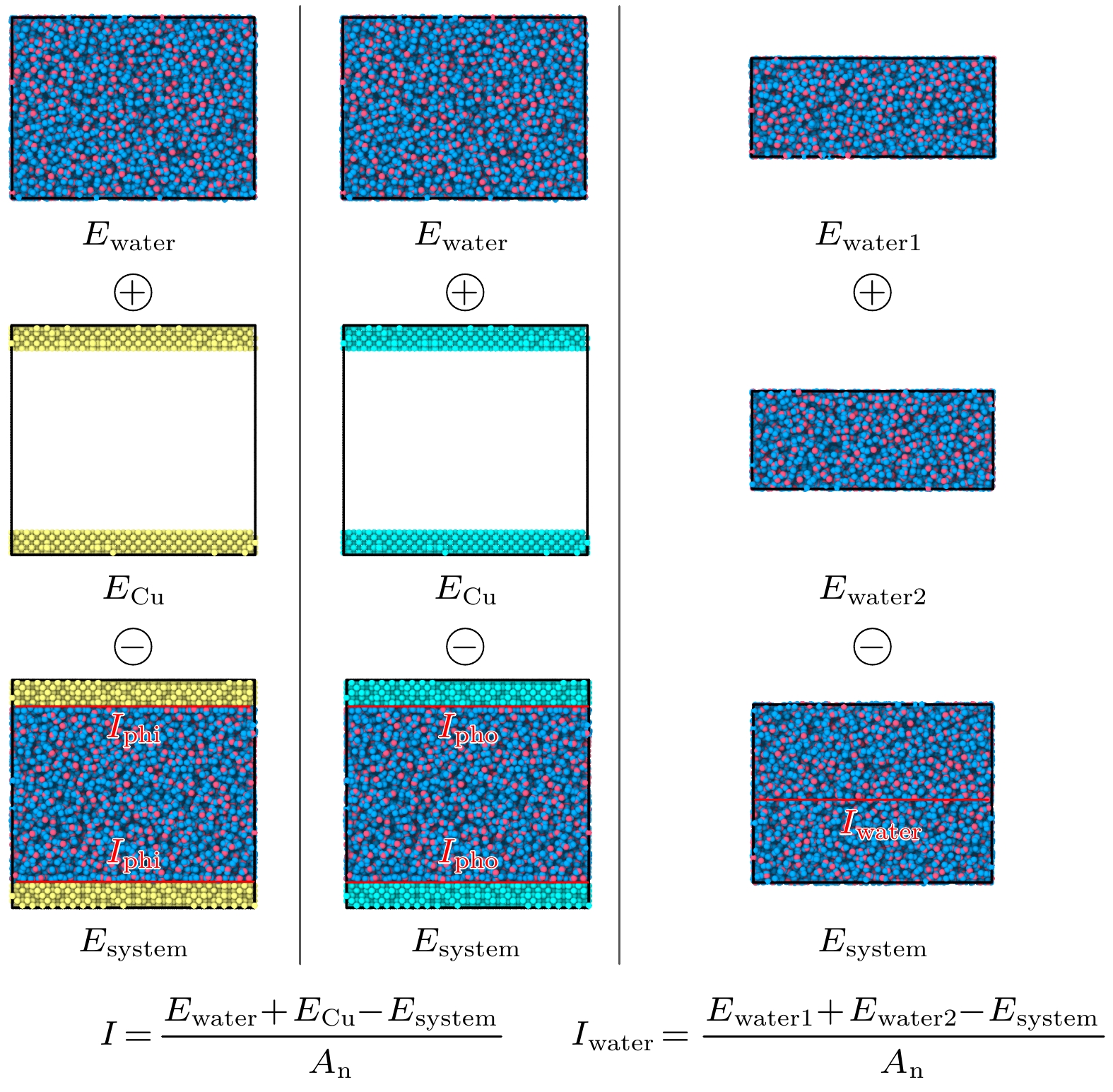-
纳米尺度下表面润湿性如何影响薄液膜沸腾传热仍是一个具有挑战性的研究. 本研究采用分子动力学方法探讨壁面润湿性影响纳米尺度薄液膜沸腾换热的机制. 结果发现: 亲水表面能够显著地提升沸腾换热性能, 有较早的沸腾起始时间, 较高的升温速率、热流密度和界面导热率, 以及较小的界面热阻. 通过建立二维表面势能模型, 揭示表面润湿性影响纳米尺度沸腾换热的机理. 亲水壁面的表面势能为–0.34 eV, 而疏水壁面的表面势能仅为–0.09 eV, 提升表面润湿性强化沸腾传热的本质原因是表面势能绝对值的提高. 此外, 通过计算分子间的相互作用能, 揭示了纳米尺度下亲疏水壁面的成核机理. 水分子-亲水壁面、水分子-疏水壁面和水分子内部的相互作用能分别为1.57, 0.26和0.48 eV/nm2. 亲水表面的界面能大于水分子内部的相互作用能, 因此亲水表面上气泡成核发生在水膜内部; 疏水表面上的界面能比水分子内部的相互作用能弱, 疏水表面的气泡成核发生在固/液界面处. 本研究揭示了表面润湿性如何影响纳米尺度薄液膜沸腾传热和气泡成核的主要机制.How surface wettability affects boiling heat transfer of thin liquid film on a nanoscale remains a challenging research topic. In this work, the effects of wettability on the nanoscale boiling heat transfer for a thin liquid film on hydrophilic surface and hydrophobic surface are investigated by molecular dynamics simulation. Results demonstrate that the hydrophilic surface has better heat transfer performance than the hydrophobic surface. It has a shorter boiling onset time, higher temperature, heat flux, interfacial thermal conductance, and weakened interfacial thermal resistance. The hydrophilic surface throughout has higher critical heat flux than the hydrophobic surface in both macro-system and nanoscale system. Besides, a two-dimensional surface potential energy is proposed to reveal the mechanism of wettability affecting the boiling heat transfer. The absolute value of potential energy in one regular unit of hydrophilicity (–0.34 eV) is much higher than that of hydrophobicity (–0.09 eV). That is the crucial reason why the heat transfer enhancement via improving surface wettability should be primarily the powerful surface potential energy. In addition, the interaction energy is calculated to further address the nucleation mechanism and heat transfer performance for liquid film on different wettability surfaces. The interaction energy values are ordered as Iphi (1.57 eV/nm2) > Iwater (0.48 eV/nm2) > Ipho (0.26 eV/nm2), indicating that the better heat transfer performance of hydrophilic surface is because of the large interaction energy at the solid/liquid interface. Besides, the bubble nucleation on a hydrophilic surface needs absorbing more energy and occurs inside the thin liquid film, while it needs absorbing less energy and triggering off at the solid/liquid interface with hydrophobicity. Those uncover the principal mechanisms of how wettability influences the bubble nucleation and boiling heat transfer performance on a nanoscale.
-
Keywords:
- wettability /
- surface potential energy /
- interaction energy /
- thin liquid film boiling /
- molecular dynamics
[1] 曹春蕾, 何孝天, 马骁婧, 徐进良 2021 物理学报 70 134703
 Google Scholar
Google Scholar
Cao C L, He X T, M X J, Xu J L 2021 Acta Phys. Sin. 70 134703
 Google Scholar
Google Scholar
[2] 刘飞龙, 程彦锟, 张境恒, 唐彪, 周国富 2023 物理学报 72 208501
 Google Scholar
Google Scholar
Liu F L, Cheng Y K, Zhang J H, Tang B, Zhou G F 2023 Acta Phys. Sin. 72 208501
 Google Scholar
Google Scholar
[3] Xiong K N, Luo Y H, Hu Y X, Wang S F 2024 Int. J. Therm. Sci. 196 108719
 Google Scholar
Google Scholar
[4] Hu H T, Zhao Y X, Lai Z C, Hu C Y 2021 Int. J. Therm. Sci. 168 107096
 Google Scholar
Google Scholar
[5] Zhang L, Wang T, Kim S, Tan S, Jiang Y Y 2019 Appl. Phys. Lett. 115 103701
 Google Scholar
Google Scholar
[6] Zhang L, Wang T, Jiang Y Y, Kim S, Guo C H 2018 Int. J. Heat Mass Transfer. 122 775
 Google Scholar
Google Scholar
[7] Lee S W, Park S D, Bang I C 2012 Int. J. Heat Mass Transfer 55 6908
 Google Scholar
Google Scholar
[8] Jo H J, Kim S, Park H S, Kim M H 2014 Int. J. Multiphase Flow 62 101
 Google Scholar
Google Scholar
[9] 张龙艳, 徐进良, 雷俊鹏 2018 物理学报 67 234702
 Google Scholar
Google Scholar
Zhang L Y, Xu J L, Lei J P 2018 Acta Phys. Sin. 67 234702
 Google Scholar
Google Scholar
[10] Wang Y H, Wang S Y, Lu G, Wang X D 2019 Int. J. Heat Mass Transfer 132 1277
 Google Scholar
Google Scholar
[11] Cao Q, Cui Z 2019 Numer. Heat Transfer, Part A 75 533
 Google Scholar
Google Scholar
[12] Hens A, Agarwal R, Biswas G 2014 Int. J. Heat Mass Transfer 71 303
 Google Scholar
Google Scholar
[13] Chen Y J, Chen B N, Yu B, Tao W Q, Zou Y 2020 Langmuir 36 5336
 Google Scholar
Google Scholar
[14] Yin X Y, Hu C Z, Bai M L, Lü J Z 2019 Int. Commun. Heat Mass Transfer 109 104390
 Google Scholar
Google Scholar
[15] Wang Z, Li L 2 0122 Int. J. Heat Mass Transfer 183 122059
 Google Scholar
Google Scholar
[16] Tian P, Ge W X, Li S S, Gao L, Jiang J H, Xu Y D 2023 Chin. Phys. Lett. 40 067802
 Google Scholar
Google Scholar
[17] 曹炳阳, 张梓彤 2022 物理学报 71 014401
 Google Scholar
Google Scholar
Cao B Y, Zhang Z T 2022 Acta Phys. Sin. 71 014401
 Google Scholar
Google Scholar
[18] 张龙艳, 徐进良, 雷俊鹏 2019 物理学报 68 020201
 Google Scholar
Google Scholar
Zhang L Y, Xu J L, Lei J P 2019 Acta Phys. Sin. 68 020201
 Google Scholar
Google Scholar
[19] Mao Y J, Zhang Y W 2014 Appl. Therm. Eng. 62 607
 Google Scholar
Google Scholar
[20] 曹炳阳, 陈民, 过增元 2005 高等学校化学学报 26 277
 Google Scholar
Google Scholar
Cao B Y, Chen M, Guo Z Y 2005 Chem. J. Chin. Univ. 26 277
 Google Scholar
Google Scholar
[21] Zhong X G, Liu Y S, Yao Y C, He B, Wen B H 2023 Chin. Phys. B 32 054701
 Google Scholar
Google Scholar
[22] Li Y Y, Li Y, Jiao W, Chen X Q, Lu G 2021 Int. J. Heat Mass Transfer 170 120996
 Google Scholar
Google Scholar
[23] Dang K, Chen J, Rodgers B, Fensin S 2023 Comput. Phys. Commun. 286 108667
 Google Scholar
Google Scholar
[24] Stukowski A 2010 Modell. Simul. Mater. Sci. Eng. 18 015012
 Google Scholar
Google Scholar
[25] Deng W, Ma S H, Li W M, Liu H Q, Zhao J Y 2022 Int. J. Heat Mass Transfer 191 122856
 Google Scholar
Google Scholar
[26] 唐修行, 陈泓樾, 王婧婧, 王志军, 臧渡洋 2023 物理学报 19 196801
 Google Scholar
Google Scholar
Tang X X, Chen H Y, Wang J J, Wang Z J, Zang D Y 2023 Acta Phys. Sin. 19 196801
 Google Scholar
Google Scholar
[27] Yin X Y, Hu C Z, Bai M L, Lü J Z 2020 Int. J. Heat Mass Transfer 162 120338
 Google Scholar
Google Scholar
[28] Wang W R, Huang S H, Luo X S 2016 Int. J. Heat Mass Transfer 100 276
 Google Scholar
Google Scholar
[29] Cai J J, Gong Z Q, Tan B 2023 Int. J. Therm. Sci. 184 107966
 Google Scholar
Google Scholar
[30] Surblys D, Kawagoe Y, Shibahara M, Ohara T J 2019 J. Chem. Phys. 150 114705
 Google Scholar
Google Scholar
[31] Chen Y J, Yu B, Zou Y, Chen B N, Tao W Q 2020 Int. J. Heat Mass Transfer 158 119850
 Google Scholar
Google Scholar
[32] Wang B B, Xu Z M, Wang X D, Yan W M 2018 Int. J. Heat Mass Transfer 125 756
 Google Scholar
Google Scholar
[33] Hu H, Sun Y 2016 Int. J. Heat Mass Transfer 101 878
 Google Scholar
Google Scholar
[34] 胡剑, 张森, 娄钦 2023 物理学报 72 176401
 Google Scholar
Google Scholar
Hu J, Zhang S, Lou Q 2023 Acta Phys. Sin. 72 176401
 Google Scholar
Google Scholar
[35] 赵昶, 纪献兵, 杨聿昊, 孟宇航, 徐进良, 彭家略 2022 物理学报 71 214701
 Google Scholar
Google Scholar
Zhao C, Ji X B, Yang Y H, Meng Y H, Xu J L Peng J L 2022 Acta Phys. Sin. 71 214701
 Google Scholar
Google Scholar
-
表 1 原子间作用势能参数
Table 1. Potential energy and related parameters between particles.
粒子 i, j qe/e σij/Å εij/eV H-H +0.52 0.00 0.0000 O-O –1.04 3.165 0.006998 Cu-Cu — 2.33 0.4096 Cu-H — 0.00 0.0000 Cu-O(亲水) — 2.75 0.034 Cu-O(疏水) — 2.75 0.009 -
[1] 曹春蕾, 何孝天, 马骁婧, 徐进良 2021 物理学报 70 134703
 Google Scholar
Google Scholar
Cao C L, He X T, M X J, Xu J L 2021 Acta Phys. Sin. 70 134703
 Google Scholar
Google Scholar
[2] 刘飞龙, 程彦锟, 张境恒, 唐彪, 周国富 2023 物理学报 72 208501
 Google Scholar
Google Scholar
Liu F L, Cheng Y K, Zhang J H, Tang B, Zhou G F 2023 Acta Phys. Sin. 72 208501
 Google Scholar
Google Scholar
[3] Xiong K N, Luo Y H, Hu Y X, Wang S F 2024 Int. J. Therm. Sci. 196 108719
 Google Scholar
Google Scholar
[4] Hu H T, Zhao Y X, Lai Z C, Hu C Y 2021 Int. J. Therm. Sci. 168 107096
 Google Scholar
Google Scholar
[5] Zhang L, Wang T, Kim S, Tan S, Jiang Y Y 2019 Appl. Phys. Lett. 115 103701
 Google Scholar
Google Scholar
[6] Zhang L, Wang T, Jiang Y Y, Kim S, Guo C H 2018 Int. J. Heat Mass Transfer. 122 775
 Google Scholar
Google Scholar
[7] Lee S W, Park S D, Bang I C 2012 Int. J. Heat Mass Transfer 55 6908
 Google Scholar
Google Scholar
[8] Jo H J, Kim S, Park H S, Kim M H 2014 Int. J. Multiphase Flow 62 101
 Google Scholar
Google Scholar
[9] 张龙艳, 徐进良, 雷俊鹏 2018 物理学报 67 234702
 Google Scholar
Google Scholar
Zhang L Y, Xu J L, Lei J P 2018 Acta Phys. Sin. 67 234702
 Google Scholar
Google Scholar
[10] Wang Y H, Wang S Y, Lu G, Wang X D 2019 Int. J. Heat Mass Transfer 132 1277
 Google Scholar
Google Scholar
[11] Cao Q, Cui Z 2019 Numer. Heat Transfer, Part A 75 533
 Google Scholar
Google Scholar
[12] Hens A, Agarwal R, Biswas G 2014 Int. J. Heat Mass Transfer 71 303
 Google Scholar
Google Scholar
[13] Chen Y J, Chen B N, Yu B, Tao W Q, Zou Y 2020 Langmuir 36 5336
 Google Scholar
Google Scholar
[14] Yin X Y, Hu C Z, Bai M L, Lü J Z 2019 Int. Commun. Heat Mass Transfer 109 104390
 Google Scholar
Google Scholar
[15] Wang Z, Li L 2 0122 Int. J. Heat Mass Transfer 183 122059
 Google Scholar
Google Scholar
[16] Tian P, Ge W X, Li S S, Gao L, Jiang J H, Xu Y D 2023 Chin. Phys. Lett. 40 067802
 Google Scholar
Google Scholar
[17] 曹炳阳, 张梓彤 2022 物理学报 71 014401
 Google Scholar
Google Scholar
Cao B Y, Zhang Z T 2022 Acta Phys. Sin. 71 014401
 Google Scholar
Google Scholar
[18] 张龙艳, 徐进良, 雷俊鹏 2019 物理学报 68 020201
 Google Scholar
Google Scholar
Zhang L Y, Xu J L, Lei J P 2019 Acta Phys. Sin. 68 020201
 Google Scholar
Google Scholar
[19] Mao Y J, Zhang Y W 2014 Appl. Therm. Eng. 62 607
 Google Scholar
Google Scholar
[20] 曹炳阳, 陈民, 过增元 2005 高等学校化学学报 26 277
 Google Scholar
Google Scholar
Cao B Y, Chen M, Guo Z Y 2005 Chem. J. Chin. Univ. 26 277
 Google Scholar
Google Scholar
[21] Zhong X G, Liu Y S, Yao Y C, He B, Wen B H 2023 Chin. Phys. B 32 054701
 Google Scholar
Google Scholar
[22] Li Y Y, Li Y, Jiao W, Chen X Q, Lu G 2021 Int. J. Heat Mass Transfer 170 120996
 Google Scholar
Google Scholar
[23] Dang K, Chen J, Rodgers B, Fensin S 2023 Comput. Phys. Commun. 286 108667
 Google Scholar
Google Scholar
[24] Stukowski A 2010 Modell. Simul. Mater. Sci. Eng. 18 015012
 Google Scholar
Google Scholar
[25] Deng W, Ma S H, Li W M, Liu H Q, Zhao J Y 2022 Int. J. Heat Mass Transfer 191 122856
 Google Scholar
Google Scholar
[26] 唐修行, 陈泓樾, 王婧婧, 王志军, 臧渡洋 2023 物理学报 19 196801
 Google Scholar
Google Scholar
Tang X X, Chen H Y, Wang J J, Wang Z J, Zang D Y 2023 Acta Phys. Sin. 19 196801
 Google Scholar
Google Scholar
[27] Yin X Y, Hu C Z, Bai M L, Lü J Z 2020 Int. J. Heat Mass Transfer 162 120338
 Google Scholar
Google Scholar
[28] Wang W R, Huang S H, Luo X S 2016 Int. J. Heat Mass Transfer 100 276
 Google Scholar
Google Scholar
[29] Cai J J, Gong Z Q, Tan B 2023 Int. J. Therm. Sci. 184 107966
 Google Scholar
Google Scholar
[30] Surblys D, Kawagoe Y, Shibahara M, Ohara T J 2019 J. Chem. Phys. 150 114705
 Google Scholar
Google Scholar
[31] Chen Y J, Yu B, Zou Y, Chen B N, Tao W Q 2020 Int. J. Heat Mass Transfer 158 119850
 Google Scholar
Google Scholar
[32] Wang B B, Xu Z M, Wang X D, Yan W M 2018 Int. J. Heat Mass Transfer 125 756
 Google Scholar
Google Scholar
[33] Hu H, Sun Y 2016 Int. J. Heat Mass Transfer 101 878
 Google Scholar
Google Scholar
[34] 胡剑, 张森, 娄钦 2023 物理学报 72 176401
 Google Scholar
Google Scholar
Hu J, Zhang S, Lou Q 2023 Acta Phys. Sin. 72 176401
 Google Scholar
Google Scholar
[35] 赵昶, 纪献兵, 杨聿昊, 孟宇航, 徐进良, 彭家略 2022 物理学报 71 214701
 Google Scholar
Google Scholar
Zhao C, Ji X B, Yang Y H, Meng Y H, Xu J L Peng J L 2022 Acta Phys. Sin. 71 214701
 Google Scholar
Google Scholar
计量
- 文章访问数: 6048
- PDF下载量: 413
- 被引次数: 0













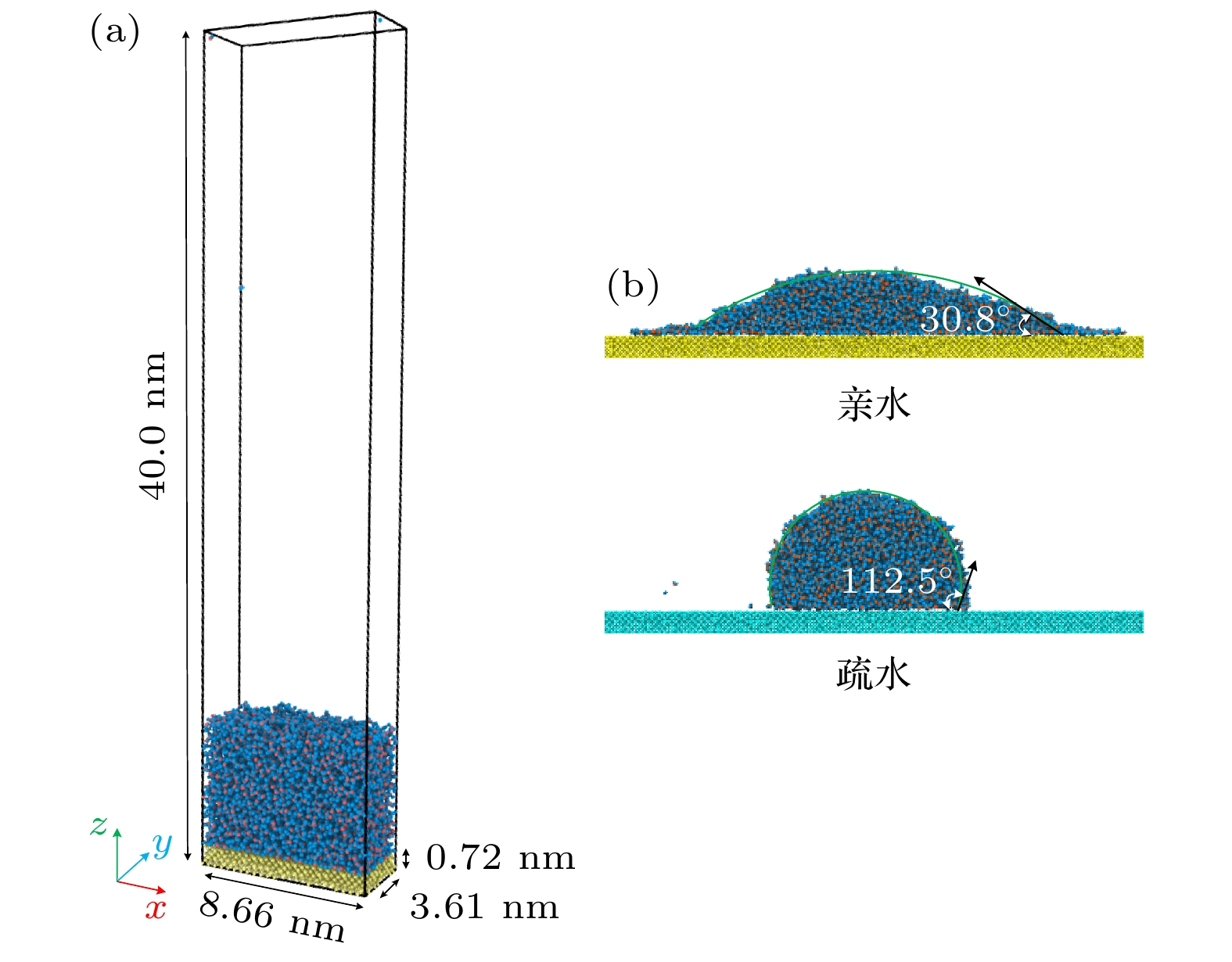
 下载:
下载:
